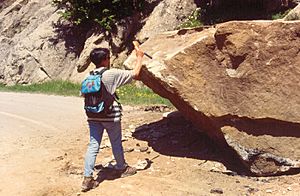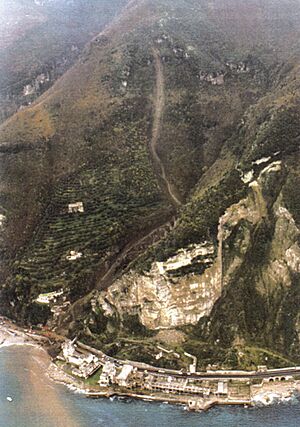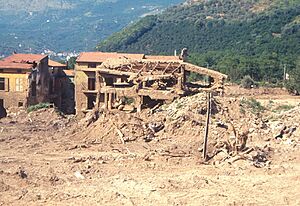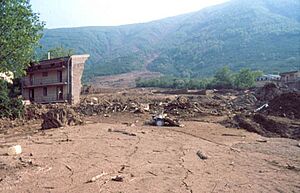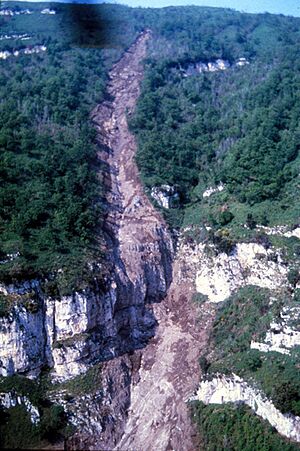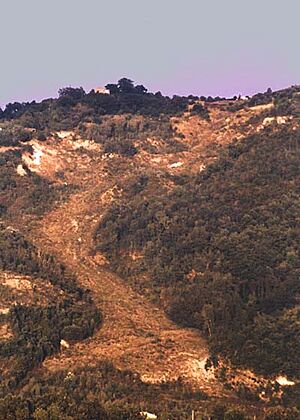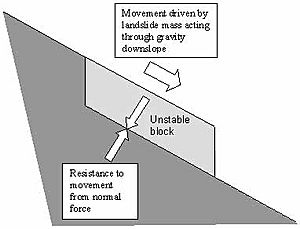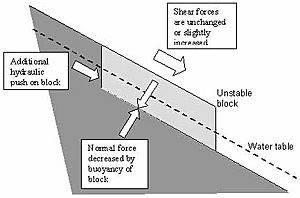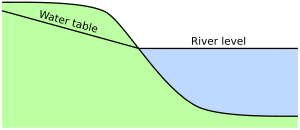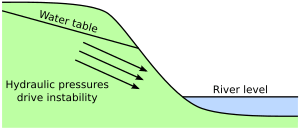Landslide classification facts for kids
Landslides are when a large amount of rock, earth, or debris moves down a slope. There are many ways to describe and classify these movements. Some definitions are very broad, including almost any type of ground movement. Others are much more specific, focusing only on certain kinds of slides.
For example, some experts consider falls, slumps, rockslides, and earthflows as types of landslides. But stricter definitions might only call "slides" true landslides, leaving out falls or flows. It depends on how scientists choose to group them.
Contents
How Scientists Classify Landslides
Scientists use different ways to classify landslides because each one is unique. Landslides don't happen in exactly the same way twice. They have different causes, move in different ways, and involve various types of ground material. Because of this, classifying them can be tricky.
Here are some main factors scientists use to describe landslides:
Type of Movement
This is one of the most important ways to classify a landslide. Landslides can move in complex ways. The main types of movement are:
- Falls: Material drops freely through the air.
- Slides: A mass of ground moves along a surface.
- Flows: Material acts like a liquid, spreading out.
- Topples: A block of material rotates forward and falls.
- Lateral Spreading: Ground spreads out sideways.
- Complex Movements: A mix of two or more types.
Material Involved
The type of material that moves is also key. Scientists usually use these terms:
- Rock: Solid rock.
- Earth: Fine-grained soil, like clay or silt. If less than 20% of the particles are larger than 2mm, it's called earth.
- Debris: Coarse-grained material, like gravel or sand. If more than 20% of the particles are larger than 2mm, it's called debris.
How Active a Landslide Is
Knowing if a landslide is still moving helps predict future events. Scientists look at:
- State: When the movement happened (e.g., active, dormant, old).
- Distribution: Where the landslide is moving.
- Style: How it is moving.
Speed of Movement
How fast a landslide moves is very important for safety. Faster landslides are more dangerous. Different types of landslides have different typical speeds.
Age of the Movement
Knowing when a landslide happened helps scientists understand how often they occur. It can also link landslides to specific events like earthquakes or heavy rains. Some landslides happened long ago, under different climate conditions.
Geological Conditions
The type of rock and soil, and how layers are arranged, greatly affects how a slope might fail. Things like cracks (discontinuities) or breaks (faults) in the rock can control where a landslide happens.
Geographical Location
Sometimes, landslides are named by where they happen, like "alpine landslides" (in mountains) or "cliff landslides." This helps describe the kind of environment and slope processes involved.
Causes of Landslides
It's important to know what causes a landslide. There are "causes" that make a slope weak and a "trigger" that starts the movement.
- Causes: Factors that make a slope likely to fail, like weak rock or a steep angle.
- Trigger: The single event that finally starts the landslide, like a big earthquake or heavy rain.
Landslides can have many causes but usually only one trigger. Sometimes, it's hard to find the exact trigger, especially if it's a slow process like rock weakening over time.
Types of Landslide Movements
Scientists like David Varnes developed a detailed way to classify mass movements. While some definitions include many types, Varnes' scheme focuses on "slides" as true landslides. Here's a simplified look at some main types:
| Type of Movement | Type of Material | ||||
|---|---|---|---|---|---|
| Bedrock | Predominantly Fine Soil | Predominantly Coarse Soil | |||
| Falls | Rockfall | Earth fall | Debris fall | ||
| Topples | Rock topple | Earth topple | Debris topple | ||
| Slides | Rotational | Rock slump | Earth slump | Debris slump | |
| Translational | Few units | Rock block slide | Earth block slide | Debris block slide | |
| Many units | Rock slide | Earth slide | Debris slide | ||
| Lateral Spreads | Rock spread | Earth spread | Debris spread | ||
| Flows | Rock flow | Earth flow | Debris flow | ||
| Rock avalanche | Debris avalanche | ||||
| (Deep creep) | (Soil creep) | ||||
| Complex and Compound | A mix of two or more main movement types | ||||
In this table, the bolded categories are what Varnes and his colleagues consider "landslides." They involve movement along a clear surface. Other types, like falls or flows, are separate categories of mass movement.
Falls
Falls happen when rock or soil breaks off a steep slope and drops through the air. It can bounce or roll down.
- Speed: Very fast to extremely fast.
- Slope: Very steep, 45 to 90 degrees.
- Causes: Shaking, erosion, digging, or weathering.
Topples
Toppling is when a mass of rock or soil rotates forward and falls away from a steep slope.
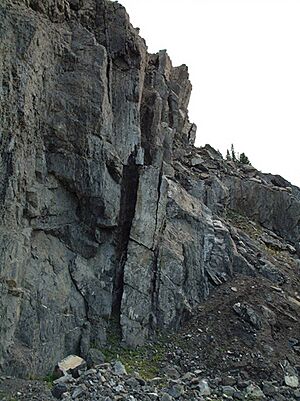
- Speed: Very slow to extremely fast.
- Slope: Very steep, 45 to 90 degrees.
- Causes: Shaking, erosion, digging, or water/ice in cracks.
Slides
A slide is when a mass of soil or rock moves downslope along a specific surface or thin zone of intense movement.
Translational Slides
In a translational slide, the ground moves along a flat or wavy surface, sliding out over the original ground.
- Speed: Very slow to extremely fast (over 5 meters per second).
- Slope: Moderate, 20 to 45 degrees.
Rotational Slides
Rotational slides move along a curved, spoon-shaped surface.

- Speed: Very slow to extremely fast.
- Slope: Moderate, 20 to 40 degrees.
- Causes: Shaking, erosion, digging, or weathering.
Spreads
A spread is when a block of strong soil or rock breaks apart and sinks into softer material underneath. The main movement is sideways spreading.
- Speed: Very slow to extremely fast (over 5 meters per second).
- Slope: Steep, 45 to 90 degrees.
- Causes: Shaking, erosion, digging, or weathering.
Flows
A flow is a continuous movement where the ground acts like a thick liquid. The movement is spread throughout the moving mass, not just on one surface.
Flows in Rock
Rock Flow
Rock flows are slow movements in solid rock where the rock deforms along many small cracks.
- Speed: Extremely slow.
- Slope: Steep, 45 to 90 degrees.
- Causes: Shaking, erosion, digging, or weathering.
Rock Avalanche
A rock avalanche is a very fast, huge, flow-like movement of broken rock from a large rockslide or rockfall.
- Speed: Extremely fast.
- Slope: Steep, 45 to 90 degrees.
- Causes: Shaking, erosion, digging, or weathering.
Flows in Soil
Debris Flow
A debris flow is a very fast flow of wet, non-sticky debris (like gravel and sand) in a steep channel.
- Speed: Very fast to extremely fast (over 5 meters per second).
- Slope: Moderate, 20 to 45 degrees.
- Causes: Heavy rainfall.
Debris Avalanche
A debris avalanche is a very fast, shallow flow of wet debris on a steep slope, not confined to a channel.
- Speed: Very fast to extremely fast (over 5 meters per second).
- Slope: Moderate, 20 to 45 degrees.
- Causes: Heavy rainfall.
Earth Flow
An earth flow is a rapid or slower, stop-and-go flow of sticky, clay-rich earth.
- Speed: Slow to rapid (over 1.8 meters per hour).
- Slope: Gentle, 5 to 25 degrees.
Mudflow
A mudflow is a very fast flow of very wet, sticky debris in a channel. It has a lot more water than the original material.
- Speed: Very fast to extremely fast (over 5 meters per second).
- Slope: Moderate, 20 to 45 degrees.
- Causes: Heavy rainfall.
Complex Movements
A complex movement is when a landslide shows a combination of different types of movement, like falls, slides, and flows, happening at the same time or one after another.
What Triggers Landslides?
Landslides are usually triggered by one main event. Here are some common triggers:
Rainfall
Heavy or long periods of rain are the most common triggers for landslides. When rain soaks into the ground, it increases the water pressure in the soil. This water acts like a lubricant, making the soil heavier and reducing its strength, which can cause the slope to fail.
For example, in May 2003, heavy rain in Sri Lanka caused hundreds of landslides, killing many people. In 1998, Hurricane Mitch triggered landslides that killed about 18,000 people in Central America.
Snowmelt
In cold, mountainous areas, rapid snowmelt can trigger landslides. When snow melts quickly, the water soaks into the ground. If the ground underneath is still frozen, the water can't drain away, leading to a rapid increase in water pressure and causing landslides. This is worse if it also rains during the thaw.
Water-Level Change
Quick changes in water levels next to a slope can also cause landslides. For example, if a river's water level drops quickly after a flood, the groundwater in the riverbank might not drain as fast. This leaves the bank with high water pressure, making it unstable.
This also happens along coasts after a storm or when reservoir levels drop suddenly. A famous example is the Vajont dam failure, where a rapid drop in lake level contributed to a landslide that killed over 2,000 people.
Rivers
Rivers can trigger landslides by eroding the base of a slope, especially during floods. This makes the slope steeper and removes support, both of which reduce stability. After a flood, the ground along the river can remain unstable for a long time.
Earthquakes
Earthquakes are another major trigger for landslides. They cause landslides in two main ways:
Seismic Shaking
Earthquake waves shake the ground, changing the forces on a slope. This shaking can make the slope unstable and cause it to fail. In mountainous areas, the shaking can be even stronger at the top of slopes, which is why earthquake-triggered landslides often extend to the very top of a hill.
Liquefaction
In some soils, earthquake shaking can cause a process called liquefaction. This is when the shaking makes the soil particles pack closer together, increasing the water pressure in the soil. The soil can then act like a liquid, leading to very fast and damaging "flow slides." This is a type of landslide almost unique to earthquakes.
Volcanic Activity
Volcanoes can cause some of the largest and most destructive landslides. These can happen during an eruption or because of weak deposits left by volcanic activity.
- Lahars: These are fast-moving mudflows made of volcanic ash, rock, and water. A famous lahar happened during the 1980 eruption of Mount St. Helens.
- Debris Avalanches: These are huge, fast-moving slides of rock and debris from a volcano's side. They can be triggered by eruptions, earthquakes, or heavy rain. The massive debris avalanche at Mount St. Helens in 1980 covered 62 square kilometers and killed 57 people.
Colluvium-Filled Bedrock Hollows
Many shallow landslides in steep mountains happen in "colluvium-filled bedrock hollows." These are U or V-shaped troughs in the bedrock where the rock has weathered into soil. As more soil builds up and water soaks in, the soil loses its strength and flows out in a landslide. Each landslide can scour out more bedrock, making the hollow deeper, and then the process repeats.
See also



